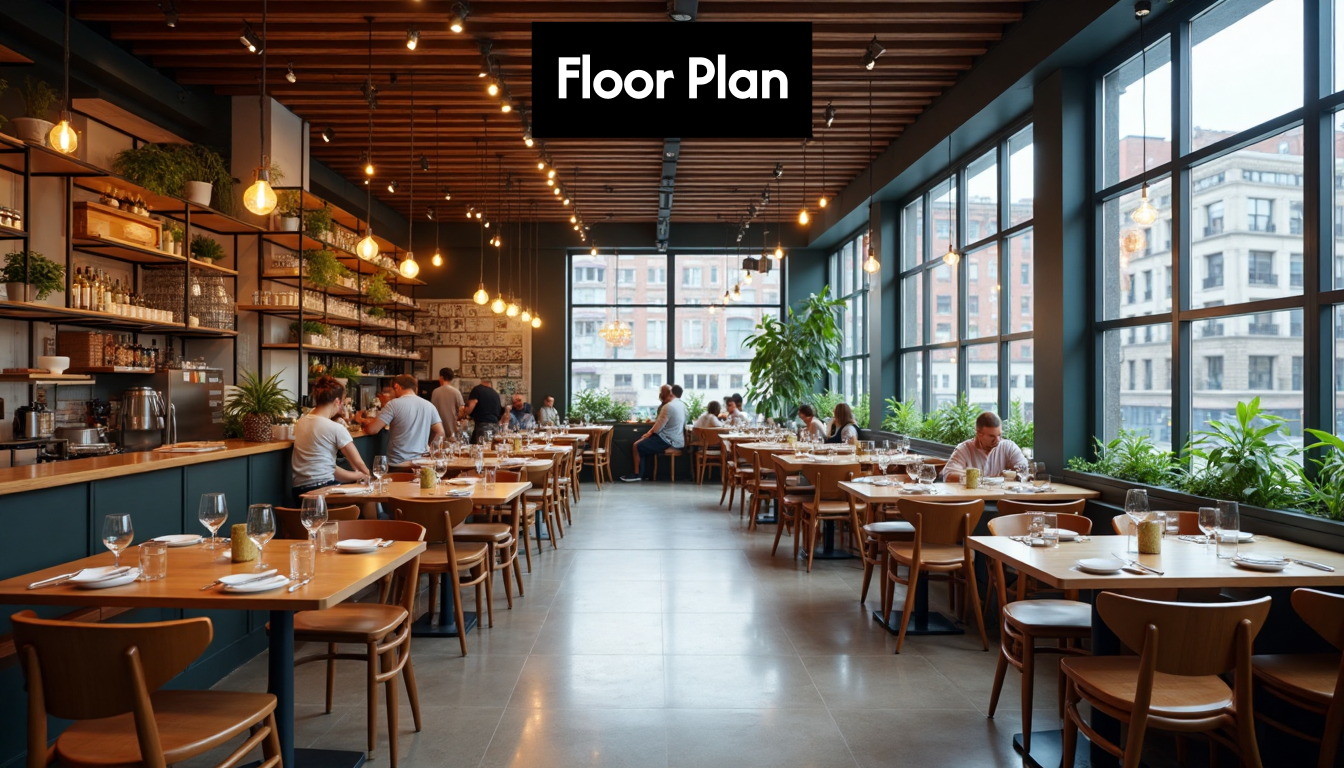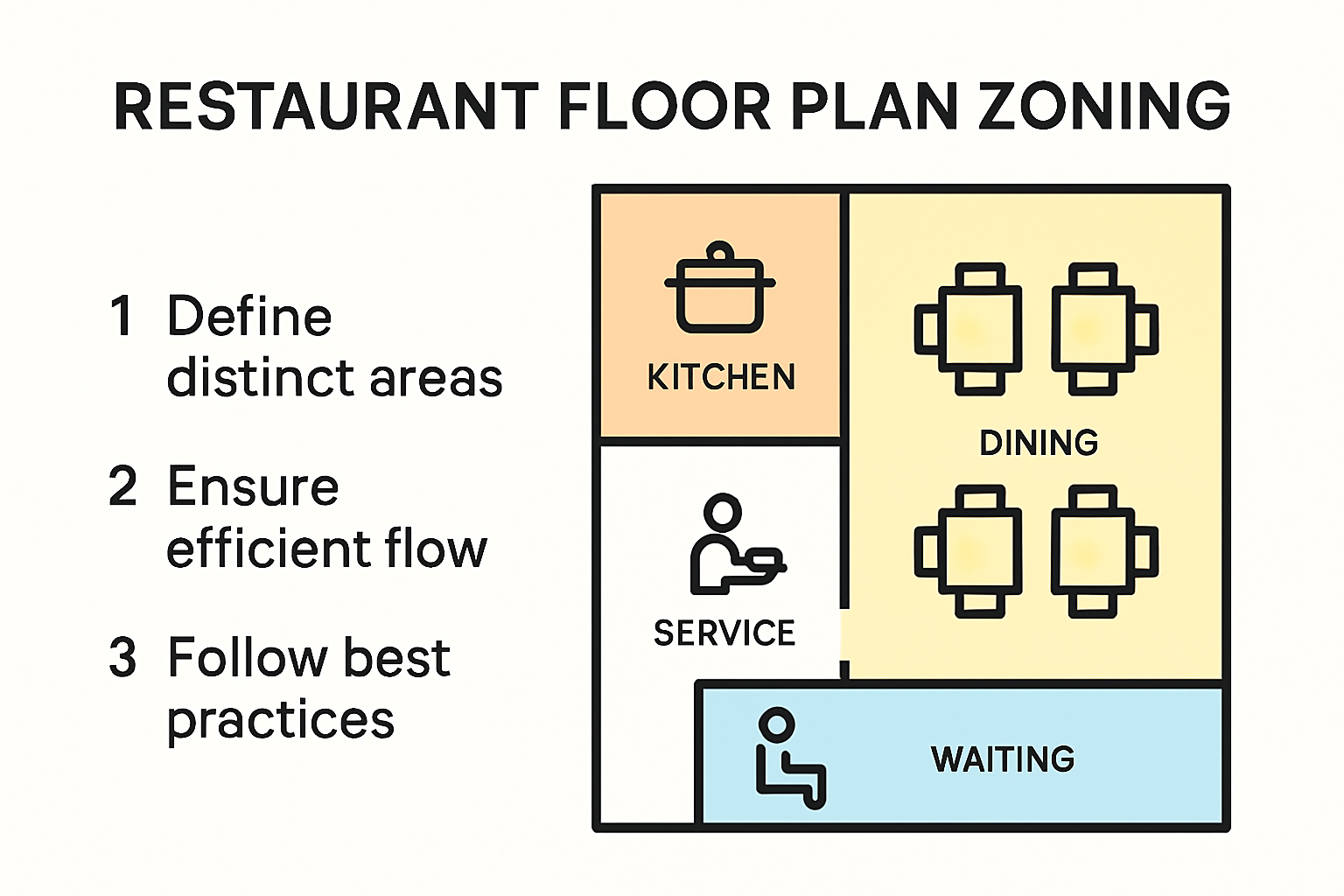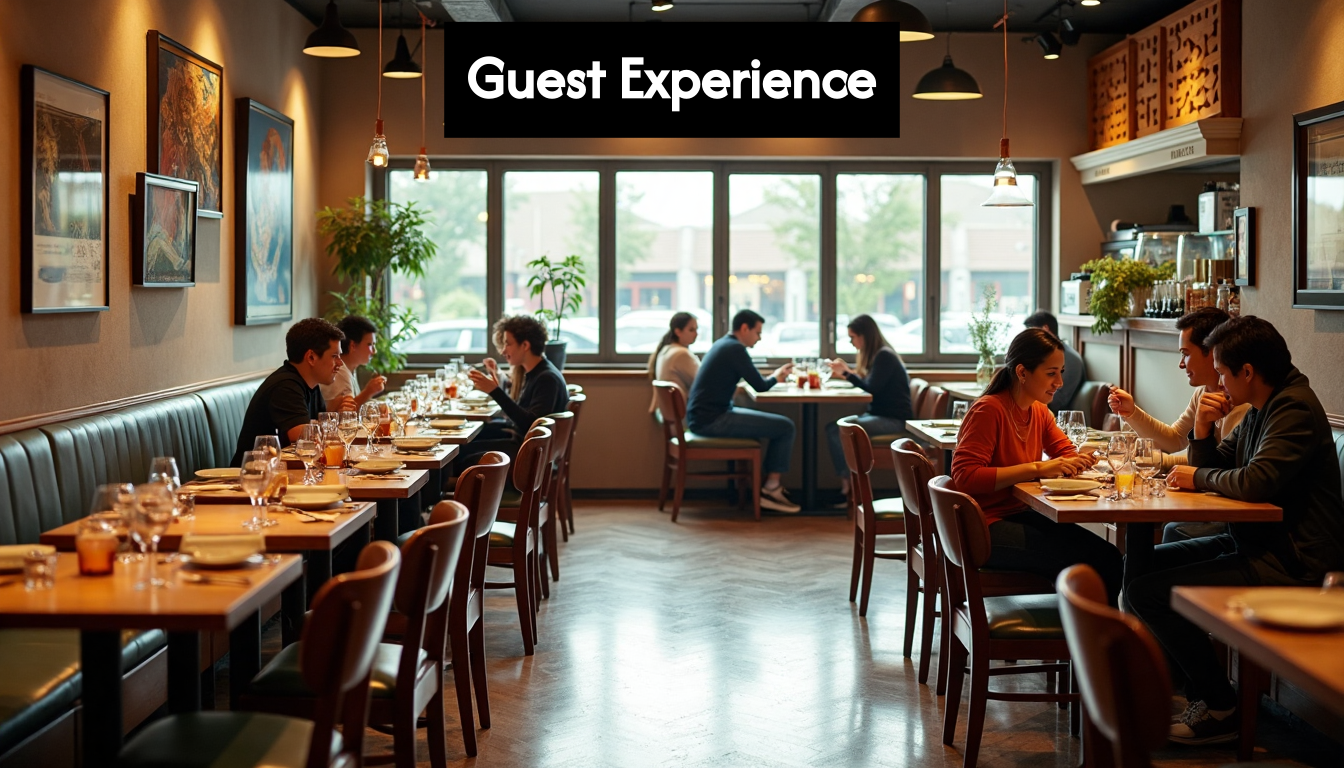Restaurant floor plan design shapes every visit and impacts daily operations far more than most diners realise. Surprise awaits, because while many obsess over décor and furniture, research shows that overcrowding caused by poor layout is the number one reason guests leave dissatisfied. The real secret isn’t just beautiful spaces, but layouts that quietly choreograph comfort, service speed and even sales. Here’s how the right design choices can change the entire dining experience.
Table of Contents
Quick summary
| Takeaway | Explanation |
| Strategic Spatial Zoning | Meticulously divide your restaurant into functional areas such as dining, kitchen, and service zones to optimise guest flow and staff efficiency. |
| Ergonomic Design Principles | Incorporate adequate table spacing and seating comfort to enhance the overall guest experience and operational efficiency. |
| Adherence to Safety Standards | Ensure compliance with safety regulations through the strategic placement of emergency exits and integration of essential services and technical infrastructure. |
| Avoiding Overcrowding | Maintain proper spacing between tables and clear service corridors to prevent bottlenecks and enhance staff mobility during peak hours. |
| Utilising Digital Design Tools | Leverage advanced digital tools for mapping and simulating floor plans to create iterative designs that enhance both operational flow and guest experience. |
Key principles of restaurant floor plan design
Designing an effective restaurant floor plan requires more than just arranging tables and chairs. It demands a strategic approach that balances operational efficiency, customer comfort, and aesthetic appeal. The blueprint of your restaurant space can significantly impact your business’s success, influencing everything from staff productivity to guest satisfaction.
Spatial zoning and flow optimization
At the core of exceptional restaurant floor plan design lies the principle of strategic spatial zoning. Explore our guide on efficient restaurant layouts to understand how precise area allocation transforms restaurant performance. According to research from iPosos, successful restaurants meticulously divide their space into functional zones: dining areas, kitchen spaces, service stations, waiting areas, and restrooms. Each zone must be proportionate and interconnected, ensuring smooth staff movement and guest navigation.
The critical aspects of spatial zoning include:
Traffic management: Create clear pathways that allow staff and guests to move without obstruction
Visibility: Ensure staff can monitor dining areas effectively
Acoustic considerations: Strategically place noisy areas like bars and kitchens to minimise disruption
Ergonomic design and guest experience
Restaurant floor plan design transcends mere spatial arrangement. It represents a nuanced interaction between physical space and human experience. According to Toast POS research, accurate measurements and thoughtful element placement directly impact restaurant ambiance and operational efficiency.
Key ergonomic considerations include:
Table spacing: Provide adequate room between tables for comfortable movement
Seating comfort: Design seating arrangements that accommodate different group sizes
Accessibility: Ensure easy access for guests with mobility challenges
Technical considerations and safety standards
Beyond aesthetics and comfort, restaurant floor plans must adhere to critical safety and regulatory standards. This involves precise placement of emergency exits, compliance with fire safety regulations, and integration of necessary technical infrastructure.
Essential technical elements include:
Emergency exit pathways: Clear, unobstructed routes
Kitchen and service area integration: Efficient workflow design
Electrical and utility considerations: Strategic placement of power outlets and service connections
A well-conceived restaurant floor plan is not just a blueprint but a dynamic framework that adapts to your restaurant’s unique identity, operational needs, and guest expectations. By prioritising strategic zoning, ergonomic design, and technical precision, restaurateurs can create spaces that not only look appealing but function with remarkable efficiency.
Remember, your floor plan is the silent orchestrator of dining experiences—design it with intention, creativity, and meticulous attention to detail.
Best layouts for different restaurant types
Restaurant floor plan design is not a one-size-fits-all solution. Different restaurant types demand unique spatial strategies that reflect their culinary concept, service style, and target audience. Understanding how to tailor your layout to specific restaurant formats can dramatically enhance operational efficiency and guest experience.
Fine dining and upscale restaurants
Learn more about optimising restaurant bar layouts to complement your dining space design. Fine dining establishments require layouts that communicate elegance and provide an intimate dining atmosphere. According to WebstaurantStore research, multi-themed spaces are becoming increasingly popular, allowing restaurants to create distinct dining zones within a single venue.
Key design considerations for fine dining include:
Table spacing: Wider distances between tables for privacy
Lighting design: Soft, ambient lighting creating an intimate atmosphere
Circulation paths: Unobtrusive service routes that minimise guest disruption
Casual and quick service restaurants
Casual dining and quick service restaurants prioritise efficiency and high turnover. The Access Group research emphasises the importance of clear service corridors and strategic seating arrangements that facilitate rapid customer movement.
Essential layout elements for casual dining include:
Open kitchen concepts: Transparent food preparation areas
Flexible seating: Adaptable configurations for different group sizes
Counter and pick-up zones: Streamlined service points
Specialised and themed restaurants
Eatertinament concepts are revolutionising restaurant design. Research from WebstaurantStore highlights the growing trend of integrating interactive entertainment elements within dining spaces. These layouts go beyond traditional restaurant designs, creating immersive experiences that attract guests seeking more than just a meal.
Considerations for themed and specialised restaurants:
Interactive zones: Areas for entertainment or themed experiences
Flexible design: Adaptable spaces for different events or performances
Technological integration: Spaces that support digital or multimedia experiences
Successful restaurant floor plans are dynamic ecosystems that balance aesthetic appeal, functional efficiency, and unique brand identity. Whether you are designing a high-end restaurant or a casual dining venue, the key is to create a space that tells a story, facilitates smooth operations, and delivers an exceptional guest experience.
Remember, your restaurant’s layout is more than a physical arrangement—it is the silent narrative of your culinary vision.
Common mistakes and how to avoid them
Restaurant floor plan design is a delicate balance of art and science, where seemingly minor errors can significantly impact operational efficiency and guest experience. Understanding and preempting common design pitfalls can mean the difference between a thriving establishment and one struggling with logistical challenges.
Spatial miscalculations and overcrowding
Check out our guide on restaurant location strategies to complement your floor plan planning. According to GoTable research, overcrowding represents one of the most critical mistakes in restaurant layout design. Restaurateurs often fall into the trap of maximising seating capacity at the expense of guest comfort and staff mobility.
Key spatial miscalculation risks include:
Tight table spacing: Restricting guest movement and comfort
Inadequate service corridors: Hindering staff efficiency
Poor traffic flow: Creating bottlenecks during peak hours
To avoid these issues, implement strategic spacing techniques:
Maintain minimum 24-inch gaps between table edges
Design clear pathways at least 3 feet wide
Create dedicated service routes separate from guest circulation areas
Hidden operational zones and visual hygiene
Visual presentation plays a crucial role in dining experience. Design Insights research highlights the critical importance of concealing service and utility areas to maintain an aesthetically pleasing environment.
Common visibility mistakes include:
Exposed kitchen areas: Revealing unappetising food preparation spaces
Visible waste zones: Creating unpleasant guest experiences
Poorly managed service stations: Disrupting dining atmosphere
Strategic solutions involve:
Using architectural screens or partitions
Implementing clever zoning techniques
Designing built-in storage for service equipment
Technology and adaptability oversights
Modern restaurant floor plans must anticipate technological integration and future adaptability. Many establishments design static layouts that quickly become obsolete as dining trends and operational technologies evolve.
Potential technological design mistakes include:
Inflexible electrical infrastructures: Limited power outlet provisions
Poor Wi-Fi coverage: Insufficient digital connectivity
Lack of modular design: Inability to reconfigure spaces
Forward-thinking design strategies involve:
Implementing comprehensive electrical grid planning
Creating versatile zones that support multiple configurations
Integrating technology-friendly architectural elements
Successful restaurant floor plan design transcends mere aesthetic considerations. It represents a holistic approach that balances operational efficiency, guest comfort, technological readiness, and brand identity. By anticipating potential design challenges and implementing proactive solutions, restaurateurs can create dynamic spaces that adapt and thrive in an ever-changing hospitality landscape.
Remember, your floor plan is a living blueprint—design it with foresight, flexibility, and a deep understanding of both current and emerging dining dynamics.
Steps to create a winning restaurant floor plan
Creating an exceptional restaurant floor plan requires a systematic approach that balances creativity, functionality, and strategic thinking. Learn more about optimising restaurant capacity to complement your design strategy. The process demands careful consideration of multiple factors that contribute to a successful dining environment.
Initial Assessment and Space Analysis
Before drafting your floor plan, conduct a comprehensive evaluation of your available space. According to The Access Group research, effective restaurant layouts prioritize operational flow and strategic zone allocation.
Key initial assessment steps include:
Precise measurements: Accurately document total floor area
Structural limitations: Identify fixed elements like columns or load-bearing walls
Existing infrastructure: Map electrical, plumbing, and ventilation systems
Natural light and visibility: Assess windows, natural illumination sources
Functional zoning and strategic layout design
WebstaurantStore research highlights the emerging trend of multi-themed spaces that cater to diverse customer preferences. Your floor plan should create distinct functional zones that support efficient operations and enhance guest experience.
Critical zoning considerations include:
Dining area configuration: Flexible seating arrangements
Service corridors: Clear paths for staff movement
Kitchen and preparation zones: Efficient workflow design
Waiting and reception areas: Comfortable guest transition spaces
Utility and storage zones: Strategically hidden support areas
Digital tools and iterative design process
Modern restaurant floor plan creation leverages advanced digital tools and iterative design methodologies. GoTable research emphasises the importance of continuous refinement and adaptability in spatial planning.
Recommended design approach:
Digital mapping tools: Utilize professional floor planning software
3D visualization: Create immersive space previews
Traffic flow simulations: Model guest and staff movement patterns
Capacity analysis: Calculate optimal seating configurations
Periodic review: Schedule regular layout assessments
Successful restaurant floor plans are living documents that evolve with your business. They represent more than geometric arrangements—they are strategic blueprints that communicate your restaurant’s identity, enhance operational efficiency, and create memorable dining experiences.
Remember, an exceptional floor plan is a delicate balance of art, science, and intuitive design. Approach it with creativity, precision, and a deep understanding of your unique culinary vision.
Frequently asked questions
What are the key principles of restaurant floor plan design?
The key principles include strategic spatial zoning to optimise guest flow, ergonomic design to enhance the guest experience, and adherence to technical considerations and safety standards to ensure compliance with regulations.
How can I avoid overcrowding in my restaurant layout?
To avoid overcrowding, maintain proper spacing between tables, ensure clear service corridors, and design dedicated pathways for staff to prevent bottlenecks during busy periods.
What layout works best for fine dining restaurants?
Fine dining restaurants typically require wider table spacing for privacy, soft ambient lighting for an intimate atmosphere, and unobtrusive service routes to enhance guest experience without disruption.
Why is it important to consider technology in restaurant floor plan design?
Considering technology in your layout ensures that spaces are equipped with the necessary electrical outlets, enables good Wi-Fi coverage, and allows for flexible configurations that can adapt to future trends and operational needs.
Unlock the full power of your restaurant floor plan
You have mastered the art of restaurant layout, but even the most strategic design cannot achieve its true potential if operations are slowed by manual bookings, cluttered front-of-house spaces, or no-show chaos. The article revealed that overcrowding and traffic flow are the quiet saboteurs of guest satisfaction, and took you through the importance of digital tools for planning and daily efficiency. These exact pain points are why intuitive reservation and floor plan management are critical for 2025 and beyond.
Streamline bookings, optimise capacity, and put your new layout to work with Tableo, the smart solution that connects digital floor plan design with automated reservations. From visual table management to real-time crowd control and guest messaging, Tableo features help you:
Eliminate bottlenecks and ensure every table is used wisely
Reduce no-shows with smart reminders and deposit options
Gain instant oversight and control, even across multiple channels
Now is the moment to turn your floor plan vision into flawless daily execution. Visit Tableo today to see how seamless integration creates a truly guest-centric, efficient space your team and customers will love.
Recommended Articles

Stephanie Paris
Gen-Z marketing coordinator bringing fresh energy to web and graphic design, with a weekend habit of chasing adventure.

Stephanie Paris
Gen-Z marketing coordinator bringing fresh energy to web and graphic design, with a weekend habit of chasing adventure.












